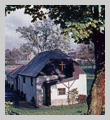
Starting the Church in Lower Bevendean
Originally Bevendean was in the Parish of Falmer, but in 1931 the
Diocese decided that Bevendean should be included in the new Parish of
Moulsecoomb with St Andrews as the main Parish church.
The Barn Church
A
former 16th century Cowshed from Bevendean Farm, at the corner of
Auckland Drive and Heath Hill Avenue and next to the Primary school,
was chosen for a temporary church.
 In
August 1953 a local paper reported that the choice of the cowshed
recalled the bibles best loved story when a cowshed, such as that to be
used in Lower Bevendean as a chapel, recalled the birth of Christ in a
barn. Where cows once stood, people will worship and where the bull was
tethered will be a font.
In
August 1953 a local paper reported that the choice of the cowshed
recalled the bibles best loved story when a cowshed, such as that to be
used in Lower Bevendean as a chapel, recalled the birth of Christ in a
barn. Where cows once stood, people will worship and where the bull was
tethered will be a font.
The new chapel was attached to the Parish of Moulsecoomb, and it was agreed that the vicar and curate of St. Andrew's (the Rev. W. R. Newton and the Rev. C. H. G. Bess) would take the services, which, it was hoped, would start in October of 1953.
Mr Bess said that,
"The area used to be in the Falmer parish, but it was so far away that
very few people could get to Falmer church.
Last November it was
transferred to Moulsecoomb, but it is still a long way to come. I know
of only one or two families from there who regularly attend St.
Andrew's".
The Dedication of the Barn Church
The
church was dedicated by the Bishop of Lewes, the Rt. Rev. Geoffrey H.
Warde, on Thursday 8th October 1953 who conducted the service with the
Rev. W. R. Newton and the Rev. Cyril Bess, both of St Andrews Church,
Moulsecombe, in whose parish the new church lies.
The church was intended to hold 65 worshippers, but so many wanted to attend its dedication service that 120 crowded into the building, and more clustered round the door and sang the hymns in the chill night air.
In the little building, with its whitewashed walls and oak beams, the Bishop said that the dedication of the church gave him great satisfaction.
The first Vicar at Bevendean was the Rev. Kenneth George Chapman, who was appointed in October 1954.
The porch was built mainly through the efforts of a local chef and the church secretary. As the church had no money to buy materials they collected bricks and flints from the derelict buildings which then stood round the church.
Not long afterward a miniature belfry was added. The work was carried out by a shipwright, the grandfather of one of the children baptised there. The wood once formed part of the old coastguard cottages at Lancing and the bell came from a yacht. The gilded cross on the outside of the church was another example of the skill of the chef.
Immediately inside the entrance stood the font, which came from the bombed church of St Cuthman's at Whitehawk. It stood on the very spot that the bull was once tethered.
Holy Nativity was very much a do-it-yourself church. The communion rails and hymn boards were made by a local carpenter and the candle sticks on the altar were cut to size on a lathe by a boy at school.
The choir stalls came from a bombed church and were skilfully adapted by the people’s warden while the choir cassocks were cut out by a retired tailor and sown together by some of the ladies of the young wives group.
 In
the north corner was another reminder of the nativity. An exquisite
Madonna and child worked in pottery which came from Prague and was a
gift of a parishioner of St James, North Lancing.
In
the north corner was another reminder of the nativity. An exquisite
Madonna and child worked in pottery which came from Prague and was a
gift of a parishioner of St James, North Lancing.
As can be imagined it was at Christmas, the festival of our Lords Birthday, that the church of the Holy Nativity came into its own.
Demolition of the Barn Church at Bevendean
On the 26th September 1970 the Argus had the following report about the
demolition of the Barn Church on Farm Green at Bevendean.
The old barn church bites the dust
AFTER more than three years of lying derelict the old bam church at Lower Bevendean, Brighton, is being demolished.
For most of its life the barn was used as a cow shed but about 16 years
ago it was taken over by the people of St. Andrew's parish living in
Lower Bevendean because they wanted a church of their own.
The parishioners converted the barn themselves at a cost of only about
£2,000. Neighbouring churches donated seats and an altar and a
piano were given.
It was because of this perfect setting for a nativity that the church
was named the Church of the Holy Nativity; a name retained by the new
church, built three years ago in Norwich Drive, Lower Bevendean.

A bulldozer demolishing the Old Barn Church at Bevendean in September 1970
